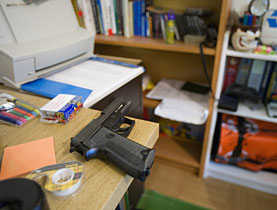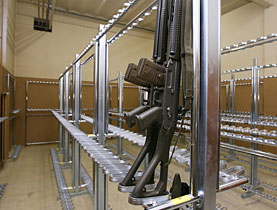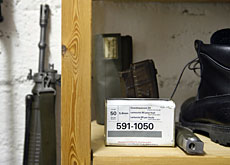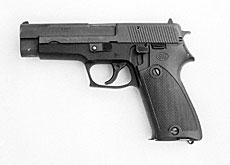Young Swiss hold European record for gun suicide

Almost half of all suicides by Swiss youngsters are committed using a gun, according to an international survey.
This is directly linked to liberal Swiss gun laws and the easy access to firearms, said researchers from the European Alliance Against Depression, whose study is published in the current edition of the Journal of Affective Disorders.
The research showed that 43.6 per cent of suicides in Switzerland committed by 15- to 24-year-old men involve guns. This is far ahead of Finland (28 per cent) and France (19.1 per cent), which were second and third. In neighbouring Germany, the figure was only five per cent.
In all, the researchers examined 15,000 suicides in 15 countries.
There are an estimated two million firearms in circulation in Switzerland, which has a population of 7.2 million.
Switzerland has an arms tradition going back hundreds of years and soldiers of the country’s militia army must keep a rifle or handgun at home after their first training period. There are more than 150,000 active members of rifle clubs.
There are also very permissive laws for obtaining a firearm in Switzerland, whereby anyone can sell his own weapon to someone else, the study added.
Young people are a particularly high-risk group when it comes to suicides, Florian Irminger, coordinator for the Stop Suicide Association, told swissinfo.
“They often act impulsively when they lose control of themselves and the availability of a weapon at home facilitates this impulsiveness,” he said.
Urs Hepp, a psychiatrist and suicide expert in the Aargau region, told the NZZ am Sonntag newspaper that youth who consider suicide do not necessarily want to die, but also do not want to live in their current situations.
He believes the transition for young people in Switzerland from adolescence to adulthood is a difficult time, putting them at risk.
“…they believe suicide is the only way out,” Hepp said. “Often people realise very quickly that they are happy to continue living.”
Fewer guns equals…
Reducing access to firearms in Switzerland would lead to fewer suicides, said Barbara Weil, from the Initiative for the Prevention of Suicide in Switzerland.
“We can prove that in other countries which have tightened their laws concerning the availability of guns, it also changed suicide rates considerably, such as in Canada, Australia and Britain,” said Weil.
In Australia, the number of households with guns was halved from 20 to ten per cent during the 1980s and the percentage rate of gun suicides fell from 30 to 19 per cent.
Opponents say people wanting to kill themselves simply turn to other methods, but this is not true, said Irminger.
He pointed to Austria where the introduction of restrictive firearms legislation significantly decreased the rate and percentage of firearm suicides without leading to an increase in other suicide methods.
National prevention strategy
The number of suicides in Switzerland is currently around 1,400 a year, with 19.1 deaths per 100,000 inhabitants – above the European average.
Why is the rate so high for a country with one of the highest standards of living in the world?
“This is the only question we can’t answer with a single straightforward answer,” said Weil. “In each individual case there are always three to four factors that lead people to commit suicide.”
But one major influential factor is that Switzerland has no national suicide prevention strategy, she added.
Switzerland is currently preparing a new federal law on health prevention and promotion for 2012 to allow the government to take action on fields of mental illness.
“Before then they don’t have the legal basis to take action, like it’s possible in HIV/Aids, addictions, alcohol and tobacco,” said Weil.
“Some cantons are interested in prevention and are doing things, but there is no strategy at the national level,” she added.
Irminger agreed that national objectives and a better coordination of cantonal efforts were needed.
“We don’t understand the current approach to suicide prevention, which is outdated,” he said. “The government presents suicide as a problem linked to schizophrenia or depression. But studies in other countries show that 40-60 per cent of cases are not connected to depression; we need to do campaigns focusing on suicide itself.”
“For young people you need to talk about suicide, as there is a fascination at that age; you need to confront it and pass the message that it’s problematic but you can find solutions.”
swissinfo, Simon Bradley
The high number of gun-related suicides in Switzerland hit the headlines in April 2006 when the husband of Corinne Rey-Bellet, a former women’s ski champion, killed her and her brother with his army pistol and then shot himself.
There are about two million firearms in circulation in Switzerland.
Among those demanding tighter gun laws are Amnesty International, Ipsilon (the Initiative for the Prevention of Suicide in Switzerland) and the Swiss Society of Psychiatry and Psychotherapy.
In 2000, around one million people killed themselves worldwide: a mortality rate of 16 per 100,000 people, or one death every 40 seconds.
The number of suicides in Switzerland is around 1,400 a year, with 19.1 deaths per 100,000. Suicide accounts for more deaths than car accidents, drugs and Aids combined.
The average suicide rate for 15-24 year-olds is 18.1 deaths per 100,000. The study average was 11.0 deaths per 100,000.
In the last 45 years, suicide rates have increased by 60% worldwide. Suicide is now among the three leading causes of death among those aged 15-44 years (both sexes); these figures do not include unsuccessful attempts which are up to 20 times more frequent than successful ones.
Traditionally suicide rates have been highest among the male elderly but rates among young people have been increasing to such an extent that they are now the group at highest risk in a third of countries. (source: WHO)

In compliance with the JTI standards
More: SWI swissinfo.ch certified by the Journalism Trust Initiative




You can find an overview of ongoing debates with our journalists here. Please join us!
If you want to start a conversation about a topic raised in this article or want to report factual errors, email us at english@swissinfo.ch.